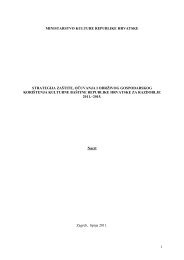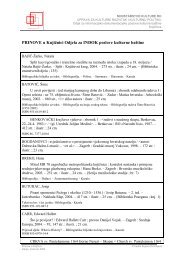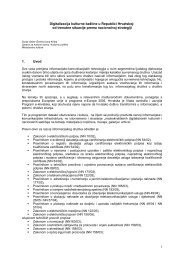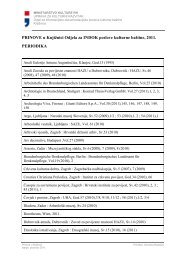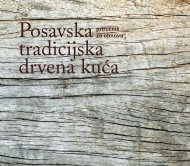Gašpina mlinica u Solinu - Ministarstvo kulture RH
Gašpina mlinica u Solinu - Ministarstvo kulture RH
Gašpina mlinica u Solinu - Ministarstvo kulture RH
Create successful ePaper yourself
Turn your PDF publications into a flip-book with our unique Google optimized e-Paper software.
210 | Godišnjak zaštite spomenika <strong>kulture</strong> Hrvatske 33/34-2009./2010.<br />
Summary<br />
CONSERVATION AND RESTORATION INTERVENTI-<br />
ONS ON A DECORATIVE SILK FABRIC FROM CHINA<br />
Flat two-dimensional textile items come in a variety of shapes, colours<br />
and manufacturing techniques. The item’s purpose frequently determines<br />
its appearance and size. Unlike tapestries which are often large<br />
in format and are exhibited vertically, smaller items used to cover up<br />
other objects such as vellums or as in this case a decorate table mat,<br />
are exhibited horizontally, Regardless of that each item represents a<br />
challenge for the restorer and requires a specific approach and careful<br />
consideration regarding the type of treatment and future conditions of<br />
safekeeping. The treatment is based on the assessed state and detailed<br />
diagnostic and historical-artistic research.<br />
The decorative embroidered silk fabric discussed in this work was brought<br />
to be restored from a private source and the work on it was done<br />
in the fabrics restoration workshop/laboratory of the University in Dubrovnik.<br />
The fabric was used as a decorative table mat on a wooden<br />
holder that was fitted into the central part of a baroque table. It was<br />
most probably manufactured in China but the specific workshop and<br />
artist are unknown. It was made of beige silk, 94.2 cm x 37.8 cm in<br />
dimension with the surface decorated by multi-coloured embroidery<br />
with floral and entomologic motifs. Silk thread of various colours and<br />
shades was used for the embroidering. Due to inadequate exposure,<br />
mechanical damage, photo-chemical changes, chemical interaction<br />
with the wooden holder the item was in quite poor shape and required<br />
conservation and restoration interventions.<br />
Based on the structural analysis of the material, analysis of fibres and<br />
analysis of the various damages to the item, important information<br />
was obtained which determined the approach and course of the more<br />
demanding phases of works, such as cleaning and consolidating the<br />
damages. Although the workmanship of the item and its material (silk)<br />
were not demanding, in certain phases of restoration special consideration<br />
and problem solving was required.<br />
The regular procedure of analytical and diagnostic research resulted in<br />
the precise selection of the approach, methods and means, proposed<br />
interventions and in the establishment of their sequence which all have<br />
to be elaborated prior to undertaking any work.<br />
Various mechanical, photo-chemical and biological damages were manifested<br />
in the form of dryness, brittleness, loss of mechanical features,<br />
yellowish colouring, changes in colour generally, etc. Particularly distinctive<br />
were the areas with yellow blotches that were the result of chemical<br />
14 Predmet nakon radova u paspartuu (foto:<br />
Tajana Kera)<br />
Item after work on the passé-partout (photo<br />
by Tajana Kera)<br />
damages in the silk caused by the effects of the acids from the wood.<br />
Within the preliminary research of the item it is always necessary to undertake<br />
a structural analysis of the material in order to acquire as much<br />
information as possible. In this case it included a textile-technological<br />
analysis. The composition of the raw material was also researched and<br />
it enabled the bringing of important decisions on the further phases<br />
of work which included the manner of cleaning the item and selecting<br />
adequate materials for under-laying and consolidating the damages.<br />
By comparing pictures with reference samples it was concluded that<br />
all the fibres used in the making of this item were of animal/protein<br />
origin, namely, fibroin silk fibres.<br />
After the mechanical cleaning of the item, the wet cleaning phases<br />
were a special challenge. Due to the multi-colour silk threads of the<br />
embroidery whose colours were not steady, in the process of washing<br />
there was a high possibility of their leakage and capillary spreading on<br />
the adjacent part of the embroidery and material. For that reason the<br />
method of cleaning on the vacuuming table with a sucking volume regulator<br />
was used. The harmful impurities were removed from the item,<br />
the pH of the item was regulated and the shine, elasticity and flexibility<br />
of the item re-established.<br />
The consolidation and restoration phase of the damaged structure of<br />
the silk underlining and multi-colour motifs on the face of the item was<br />
carried out by the application of three different methods, depending<br />
on the type and degree of damage. By underpinning the entire item<br />
its structure was stabilized, sewing fixed the protruding threads, holes<br />
and threadbare areas while the severely damages portions of the embroidery<br />
were protected by fine tulle.<br />
The selection of the best way of safekeeping and exhibiting the item was<br />
achieved in cooperation with colleagues working on the restoration of<br />
paper. The goal was to conserve the item and preserve it for the future<br />
while respecting the original shape and by using reversible methods<br />
and corresponding materials of high restoration quality. Given that the<br />
original way of exhibiting this textile item was no longer acceptable<br />
due to its sensitive and degraded structure it was necessary to solve<br />
the issue of the best method of its safekeeping and exhibiting. After<br />
consultations with the owner it was agreed that the item be prepared<br />
for exhibition in the form of a wall picture. By the placing the item on<br />
a passé-partout with a protective anti-static foil conditions for its safekeeping<br />
and exhibiting were met. In this way its aesthetic component<br />
has been preserved while a copy of the original can be placed on the<br />
wooden holder in its original position.




